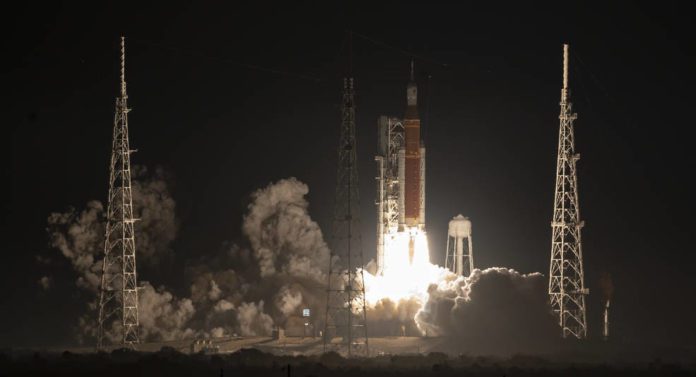
|
Getting your Trinity Audio player ready...
|
Well into the early hours of November 16, 2022, NASA launched its unmanned Artemis I mission to bring the United States back to the moon for the first time since the Apollo missions ended in 1972. The Kennedy Space Center, east of Orlando, Florida, roared to life with rockets that produced a shocking two million pounds of thrust, lifting the novel Orion spacecraft into Earth’s orbit and onwards towards the moon.
So, what’s the significance of Artemis I? The Artemis missions mark the start of a new age in human space exploration. The end goal for NASA is to ultimately establish a permanent human presence on the moon, create a lunar space station and boast the world’s first lunar satellite. This will allow us to research the moon and its water sources as well as create a foothold through which NASA can launch space missions into deep space.
The technological marvels that went into pursuing such an endeavor are nothing to scoff at. Artemis I will serve as a vital test to see if NASA has what it takes to create livable conditions outside of Earth. Water reservoirs on the moon will be used as a drinking source, but in many cases, the hydrogen in water can be used as fuel and the oxygen can be used to create breathable air. Both of these resources are crucial in making space travel economically feasible and habitable. It is no small task to launch space missions and the rockets used for this mission utilized hydrogen fuel, making them the most powerful rockets ever created. Then comes Artemis I’s crowning achievement, the Orion Space Module. This spacecraft will eventually be used to house the astronauts that will one day be walking on the moon. It features four, 62-foot solar panels that will supply the module with enough power to get to the moon and back; something that was not present in the Apollo spacecrafts. The Artemis I launch was also the debut of Orion’s Launch Abort System, a computer that monitors all of the mission’s systems and should anything go wrong, immediately break away from the rocket and ferry the astronauts to safety. Fortunately, last night the system was not needed and Orion is well on its way to the moon.
Here is a recap of the launch:
So, what’s the plan? Where does NASA go from here and will more launches be happening at the Kennedy Space Center? Artemis I is primarily trying to test all of NASA’s most recent technological innovations but it’s also testing one crucial question for future astronauts. When astronauts leave the atmosphere, they are exposed to some fairly dangerous radiation from the Sun. When astronauts leave the Earth’s protective magnetic sphere, the Van Allen Belt as it’s called, the amount of radiation astronauts will be exposed to spikes again. Artemis I carries with it various packages of organic payloads ranging from plants, fungi, yeast, and algae to allow NASA to study how life from Earth behaves and survives when exposed to such radiation. In an ideal world, these forms of life adapt well enough for space stations to engineer local greenhouses to sustain the astronauts and scientists that will inhabit them.
Looking ahead, Artemis II will be its first manned mission and will perform a lunar flyby in May 2024, serving as a test for Orion’s computer systems with astronauts on board. Should it succeed, Artemis III will launch in 2025 and will likely land astronauts on the moon near its South Pole, where the largest stores of ice water can be found. Future missions will feature the establishment of a lunar satellite and a ground space station, allowing NASA to begin assembling the necessary components to launch its Mars exploration missions from the moon itself.
Andres Pena is a Pinecrest resident and graduate of New York University with degrees in both English and American Literature and Political Science





